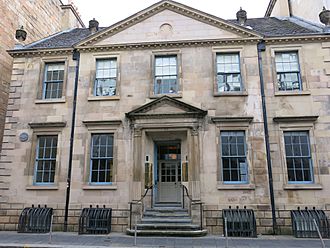Tobacco Merchant's House facts for kids
Quick facts for kids Tobacco Merchant's House |
|
|---|---|

Tobacco Merchant's House
|
|
| Former names | Baillie Craig's House |
| General information | |
| Architectural style | Simplified Palladian |
| Location | NGR: NS 59212 65125 |
| Address | 42 Miller Street, Glasgow, Scotland, UK |
| Town or city | Glasgow |
| Country | Scotland, UK |
| Coordinates | 55°51′31″N 4°15′03″W / 55.85872°N 4.25092°W |
| Completed | 1775 |
| Design and construction | |
| Architect | John Craig |
| Renovating team | |
| Renovating firm | McGurn, Logan, Duncan and Opfer |
| References | |
| http://portal.historicenvironment.scot/designation/LB32760; http://www.scottisharchitects.org.uk/building_full.php?id=421530; https://canmore.org.uk/site/140740/glasgow-42-miller-street-baillie-craigs-house | |
The Tobacco Merchant's House is a historic building in Glasgow, Scotland. It is also known as Baillie Craig's House. This old villa was built in 1775 and is the last remaining house of a Virginia tobacco merchant in Glasgow. It stands at 42 Miller Street in an area called Merchant City.
The house was completely updated in 1994 and 1995. Today, it serves as the main office for the Scottish Civic Trust. This trust works to protect and improve Scotland's built heritage.
Contents
What is the History of the Tobacco Merchant's House?
How the House Started in the 1700s
The Tobacco Merchant's House was built in 1775. It was designed by a Glasgow architect named John Craig. He actually built the house for himself to live in. Craig bought the land from a merchant from America named Robert Hastie.
John Craig was known as an architect. He even called himself 'architect to His Royal Highness the Prince of Wales'. In 1782, Craig sold the house to Robert Findlay of Easterhill. Findlay was a very successful tobacco importer. At that time, Miller Street was a popular place for rich Glasgow merchants to live.
Changes in the 1800s
Robert Findlay's son, Robert Findlay Jr., later developed the Virginia Buildings nearby. These buildings were used by tobacco traders in the early 1800s. Findlay Jr. sold the house at 42 Miller Street to his family's business.
Over time, the house was used by different people and businesses. It was home to a lawyer and various merchants. It also served as an office for a bank, the Thistle Bank. Later, it became the office for the City & Suburban Gas Company.
How the Building Changed Over Time
Towards the end of the 1800s, some changes were made to the house. A famous architectural company in Glasgow, Honeyman and Keppie, worked on it. A well-known architect named Charles Rennie Mackintosh was working there at the time. One of the changes they made was adding a special roof called a mansard roof. This roof was later removed during future renovations.
The House in the 1900s
The building continued to be used for many different things in the 1900s. At one point, it was even a dress shop. People started to realize how important this building was to history. In 1970, it was officially listed as a historic building. Its importance was recognized even more in 1992 when its listing was upgraded.
Why Was the House Renovated?
By the 1990s, the Tobacco Merchant's House was in very bad condition. It was empty and falling apart. A company offered to give the building to the Glasgow Building Preservation Trust. The trust agreed to fix it up and bring it back to life.
The renovation work started in 1994. It was done by an architectural firm called McGurn, Logan, Duncan & Opfer. The project was finished in 1995 and cost about £500,000. After the renovation, The Scottish Civic Trust bought the building. They received help from the Heritage Lottery Fund. Today, the building is their main office. It also has office spaces for other businesses.

